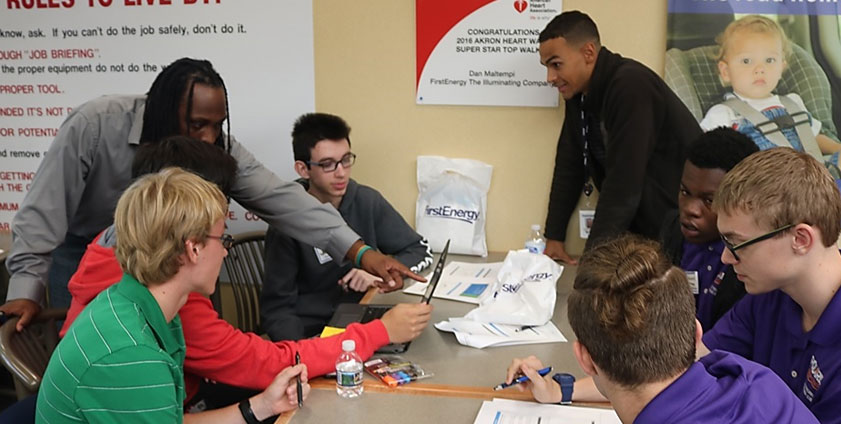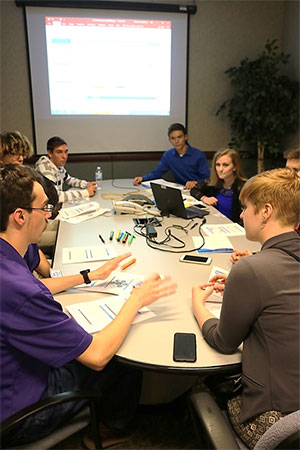FirstEnergy Encourages STEM Students to Design ‘Grid of The Future’

A Polaris team determines the best location for a power plant to support the grid.
October 5, 2018
The designers hovered over maps and computer screens, working against the clock to resolve issues facing America’s power grid. “This is where we need a nuclear plant,” said one, pointing to the screen.
It was an exercise in engineering, but also a very real test in balancing the realities of generating and delivering electricity with the common misconceptions so many have about energy.
“What happens when the wind stops blowing and the sun goes down?” asked Mark Little, one of about 95 seniors in northeast Ohio’s Polaris Career Center engineering program who attended a brainstorming session at FirstEnergy’s Northern Region Headquarters (NRHQ). “We need to build in redundancy; two forms of generation to support the system, not just one. That way you have more reliability.”
Prior to the session, students were provided prework to help them learn about the grid. Last Friday, Sept. 28, students spent the day at the NRHQ, breaking into teams supported by one experienced FirstEnergy engineer and a rotational engineer.

Taylor Poindexter (behind laptop) listens while team members discuss various generation options.
“All of these students have expressed the desire to become professional engineers in the power industry,” said Polaris instructor Ed Yager. “This is a wonderful opportunity to see professionals and hear directly from those working in the business.”
“I like the collaborative nature of what we’re doing with the students,” said Generation Supervisor, Assets Systems, Terry Malone. “We introduce them to the whole range of what we do, from generation to transmission to delivery. Our main challenge is to maintain the pipeline. Bringing in young, new minds is critical to tackling the rapidly changing nature of our industry.”
Polaris student Taylor Poindexter used an analogy as she explained the importance of grid reliability to her teammates: “We need to think of generation like a hybrid car: nuclear and fossil are the gas engine, solar and wind renewables are the electric motor, we use them when and where we can – but we have traditional generation to fall back on when we need it.”
“Solar panels, methane gas from waste, energy storage …
I’m open to all of it,” said student John Ownbey. “We know we can’t do just one thing. We know we have to transition to it, and make sure it’s reliable.”
“Our intent is two-fold,” explained Karla Hromyak, formerly manager, Recruiting, (now Employee Relations) “engage students with the understanding of the importance of engineering and, on a smaller scale, work toward a goal of bringing in a select group of high school seniors next summer as we expand the high school internship program we piloted last summer in the transmission organization.”
At the end of their brainstorming sessions, teams presented their plans. For instance, one team developed a goal of renewable energy supported by 20-percent fossil and nuclear. “We looked at the U.S. holistically, moving more to a hybrid system,” members announced. They also explained a Catch-22 they discovered: “We realized that the more we move away from fossil fuels for transportation, the more generation we will need. And that there are places where climate or geography limit renewable energy.”
“The ideas they’re coming up with are amazing,” said Terry. “We sell our kids short when we limit them based on our mindsets. Ninety-nine percent of what they come up with may not be applicable at all. But that one percent might just be the idea that transforms the world.”